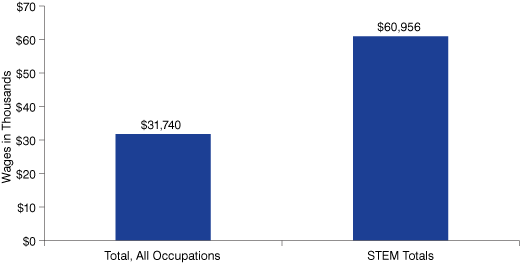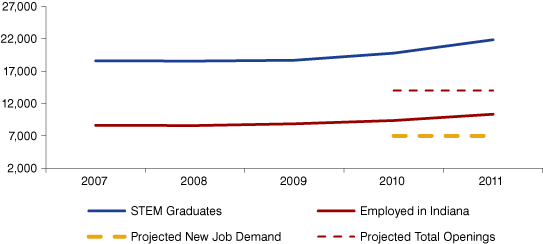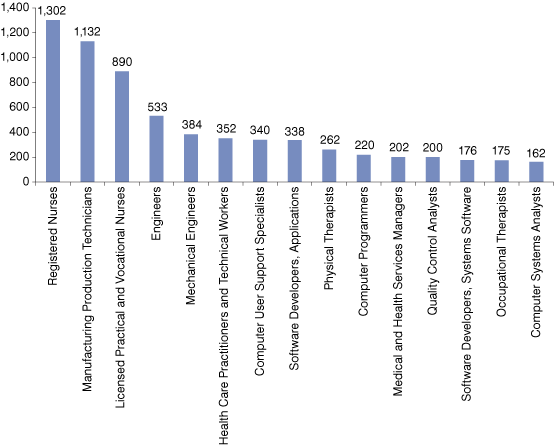Indiana's STEM Pipeline: A Surplus of Graduates
Science, technology, engineering and mathematics (STEM) degrees and occupations are of growing importance in today’s economy. High-tech and knowledge-based occupational growth is tied to innovation and has implications on the economic recovery and strength of the labor market.
While there are many definitions for what constitutes a STEM degree, job or industry, this article examines Indiana’s STEM education-to-workforce pipeline using the Indiana Workforce Intelligence System (IWIS)1 and the STEM guidelines developed by the Bureau of Labor Statistics (BLS).
The STEM guidelines are based on the August 2012 recommendations of the BLS Standard Occupational Classification Policy Council. Compared to other STEM definitions, this measure tends to be slightly broader and more inclusive. While the choice may not adhere to everyone’s expectations, the important point is to have a standardized measure across the entire study when attempting to compare the supply and demand of such graduates.
A potentially significant way in which this definition of STEM may differ from others is its inclusion of health professions and related social sciences.
Science, Engineering, Mathematics and Information Technology
- Life and Physical Science, Engineering, Mathematics, and Information Technology Occupations
- Social Science Occupations
Science- and Engineering-Related
- Architecture Occupations
- Health Occupations
Overall, five types of occupations are included in the BLS definition.2
- Research, Development, Design or Practitioner Occupations
- Technologist and Technician Occupations
- Postsecondary Teaching Occupations
- Managerial Occupations
- Sales Occupations
Some specific examples include computer and information systems managers, medical and health services managers, database administrators, civil engineers, mechanical drafters, architects, psychologists, and pharmacists.
Indiana 2020 STEM Projections
Based on the BLS methodology, there are approximately 170 STEM occupations in Indiana’s workforce, accounting for about 331,000 jobs in 2010, or 11.4 percent of all jobs in Indiana (see Table 1). This is only slightly less than the national average, where 12.7 percent of all jobs can be defined as STEM.
Table 1: Indiana Occupation Projections, 2010 to 2020
| Indicator | 2010 Base Employment | 2020 Employment Projections | Numeric Change over the Decade | Percent Change | Growth Openings | Replacement Openings | Annual Total Openings |
|---|---|---|---|---|---|---|---|
| All Occupations | 2,914,033 | 3,318,650 | 404,617 | 14% | 414,021 | 691,218 | 110,524 |
| STEM Occupations | 331,301 | 401,408 | 70,107 | 21% | 70,382 | 71,350 | 14,178 |
| STEM Occupations as a Percent of Total | 11.4% | 12.1% | 17.3% | n/a | 17.0% | 10.3% | 12.8% |
Source: Indiana Department of Workforce Development The Indiana Department of Workforce Development (DWD) projects that Indiana STEM jobs will grow at a faster rate than other occupations over the next decade. All occupations are projected to grow about 13.9 percent in Indiana from 2010 to 2020, while STEM jobs are projected to grow by 21.2 percent. By 2020, they will represent 12.1 percent of all jobs in Indiana.
The vast majority of STEM jobs in Indiana are projected to be in the health care field, which includes practitioners and technologists. The types of occupations will be predominately research oriented or technical (including supportive occupations) in nature (see Figure 1).
Figure 1: Indiana’s STEM Occupations by Domain and Occupational Type, 2020 Projections

Source: Indiana Department of Workforce Development
Not surprisingly, the importance of education and training will continue to grow in tandem. Almost all (96 percent) of these jobs require training, certification or a college degree beyond a high school diploma.
STEM Projected Job Demand in Indiana
Health care jobs have the highest projected job openings. STEM occupations with the most annual job openings include registered nurses, licensed practical and licensed vocational nurses, pharmacy technicians, and medical and health services managers.
Veterinary technologists and technicians and biomedical engineers are the fastest-growing STEM occupations, both with growth rates exceeding 50 percent over the next decade. The anticipated demand for STEM occupations will be around 7,000 new jobs annually, with an additional demand for approximately 7,000 jobs annually due to replacements and retirements.
These are jobs with good prospects and high wages. The average median wage for a STEM-related job is almost double the median wage for all Indiana occupations, $60,956 vs. $31,740 (see Figure 2). STEM positions may account for 11.4 percent of jobs for Indiana, yet half of Indiana’s “Hoosier Hot 50 Jobs” fall into the STEM categories.3
Figure 2: Indiana Median Wage Comparison, 2010

Source: Indiana Department of Workforce Development
The STEM Pipeline
What does this mean for economic development professionals and Indiana educators and job seekers? Is there a shortage of skilled STEM workers or a shortage of science and high-tech job opportunities for these graduates?
Nationally, there are plenty of anecdotal stories in the press that American students and schools are struggling and falling behind in educating our youth in science, math, engineering and technology. In Indiana, it is possible to examine this pipeline utilizing the Indiana Workforce Intelligence System (IWIS) that links education and workforce data for Indiana. It provides the opportunity for analysis of Hoosier K-12 students, all those that are educated in public state institutions, and the ability to match employment and wage outcomes for those who ultimately become employed (or unemployed) in Indiana.Starting with the BLS-defined STEM occupations and similarly aligned curriculum and degree programs, the outcomes of Indiana public institution STEM graduates for 2006 to 2010 were examined against their current employment and wage outcomes. Indiana currently has a surplus of STEM graduates. This is not surprising, given the concentration of renowned higher education institutions in the Hoosier state.
As shown in Table 2, Indiana public universities graduated between 18,500 and 21,800 STEM graduates (of all degree types) each year since 2006.4 Roughly 20 percent of these completers re-enroll for additional education and advanced degrees in the following year. Thus far, it appears that 58 percent to 60 percent remain initially employed in Indiana one, three or five years out. This is consistent with other analysis on all degree types done by the Commission for Higher Education and IWIS.5
Table 2: Employment Results One Year After Graduation for Indiana’s STEM Graduates, 2007 to 2011
| Measure | 2007 | 2008 | 2009 | 2010 | 2011 |
|---|---|---|---|---|---|
| Total Graduates | 18,585 | 18,542 | 18,669 | 19,769 | 21,833 |
| Number Employed in Indiana | 8,642 | 8,582 | 8,868 | 9,381 | 10,335 |
| Percent Employed in Indiana | 46.5% | 46.3% | 47.5% | 47.5% | 47.3% |
| Number Enrolled Post-Graduation | 3,932 | 3,688 | 3,871 | 3,812 | 4,049 |
| Percent Enrolled Post-Graduation | 21% | 20% | 21% | 19% | 19% |
| Percent Employed of Those Not Re-Enrolled | 59.0% | 57.8% | 59.9% | 58.8% | 58.1% |
| Average Wage: First Job Post-Graduation | $52,538 | $53,538 | $53,868 | $53,822 | $52,394 |
Source: Indiana Department of Workforce Development, using IWIS data
Those that do become employed in Indiana obtain an average wage of approximately $52,000 in their first year after graduation. Especially when considering that this is for a recent graduate, this is significantly higher than for all occupations. While there is always an argument to augment or expand higher education, the first step within Indiana may be to retain and employ the current Hoosier STEM pipeline. Given these higher wages, for Indiana to continue to compete nationally and to raise its own per capita income, the state will need to continue to work on accelerating the creation of STEM and other high-skilled jobs.
Even with the projected growth in the coming years, Indiana will continue to have a significant surplus of STEM-related degrees compared to projected job openings—even when accommodating for replacement jobs (see Figure 3). Hoosiers should be proud that Indiana has prestigious universities that attract students from across the nation and the globe. The state should be working hard to provide robust economic growth such that all students are able to find ample high-paying jobs in the state post-graduation. Clearly, some students will leave the state after graduation for a variety of reasons; however, the goal from a state perspective should be that all students have options to remain in the state if they would like.
Figure 3: Indiana STEM Graduates Compared to STEM Employment, 2007 to 2011

Source: Indiana Department of Workforce Development, using IWIS data
Current STEM Job Openings
If one concludes that Indiana is generating an ample supply of graduates, what are the job opportunities? The highest concentrations of graduates from all degree types come from health care, including nursing and technician support degrees and certificates. The next highest concentration is in a variety of engineering fields, biology, chemistry, and social science fields such as psychology. Computer and IT degrees are more common among the associate and bachelor’s degree graduates.
There are many current job openings for STEM-related fields particularly in the state’s larger metropolitan areas. From January 2011 through September 2013, there were over 22,500 job postings in Indiana Career Connect for STEM occupations.
The most common job postings over a four-quarter period are illustrated in Figure 4. Key industries include health care, employment services and manufacturing. The most common STEM job orders were for registered nurses, manufacturing (engineering) production technicians, and licensed practical nurses. If there are supply shortages, they are likely for niche fields that require specialized technical knowledge and expertise.
Figure 4: Top STEM Job Postings from Indiana Career Connect, 2012 Q3 to 2013 Q3

Source: Indiana Department of Workforce Development
Focusing on STEM Job Creation
Recent analysis done by the Central Indiana Corporate Partnership and the Battelle Technology Partnership Practice came to a similar conclusion: Indiana does not produce enough high-skilled job opportunities for the state’s current supply of college graduates.6 The STEM crisis may not be a candidate supply issue, but rather a continued need for job growth in these industries. Given that these STEM jobs allow for much higher wages, Indiana’s economy can benefit greatly from job creation in these areas.
Indiana fares relatively close to the national average for its concentration of STEM employment. STEM jobs encompassed about 11.4 percent of the Indiana workforce in 2010. Nationally, that concentration was only slightly higher at 12.7 percent. To illustrate what even moderate growth could do for the economy, we examined this 1.3 percent difference.
For Indiana to have a concentration equal to the national STEM concentration, we would need to generate about 38,000 new STEM jobs. If those jobs paid wages on par with the STEM average wage of $60,000—which is $28,000 greater than the state median wage—this could potentially generate an additional $1.1 billion in annual wages to the Hoosier State. This makes a telling case for educators and workforce professionals alike to focus efforts on innovation, job creation and development in the world of science, technology, engineering and math.
Notes
- IWIS is a collaborative effort among the Indiana Department of Workforce Development, the Indiana Commission on Higher Education, the Indiana Department of Education and the Indiana Business Research Center. It is a state-of-the-art research database linking student and worker records in Indiana. Learn more at https://indianaworkforceinformation.iu.edu.
- Bureau of Labor Statistics, “Detailed 2010 SOC Occupations Included in STEM,” August 2012, www.bls.gov/soc/Attachment_C_STEM.pdf.
- Learn more about the Hoosier Hot 50 at https://netsolutions.dwd.in.gov/hh50/.
- These IWIS data come from the Indiana Commission for Higher Education.
- See “Indiana Return on Investment Part II: A Closer Look at College Value” at https://indianaworkforceinformation.iu.edu/analysis.aspx.
- Batelle Technology Partnership Practice, “Indiana’s Competitive Economic Advantage: The Opportunity to Win the Global Competition for College Educated Talent,” 2012, https://mpcms.blob.core.windows.net/e30e30cc-342f-4bd2-9b6e-c5cb1c39f202/docs/1d2a86b8-577b-4cae-8223-a23222396e09/cicp_battelle-college-workforce-study.pdf.
